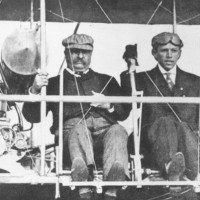News
A Short Story; A Long History: Roosevelt's Special Visit
- Details
- Published on Thursday, 07 February 2013 13:24
- Written by Ken Zurski
Theodore Roosevelt stepped off the train in Peoria around one-thirty in the afternoon on October 12, 1910, Columbus Day. The jovial ex-president wasted no time as usual. He adjusted his hat, buttoned his overcoat, and stormed towards a “feeble-looking” man who had taken a seat in the corner of the station, just beyond the crush of the well-wishers said to be in the hundreds. Roosevelt charged like a bull and swept his arms around the man as the throng erupted. “As soon as Mr. Roosevelt saw the archbishop he broke through the lines and greeted the venerable churchman,” The New-York Tribune exalted, “a movement which almost led to a riot.”
Archbishop Spalding was just as enthralled. Although his body, ravaged by a stroke in 1905, led to an early retirement for the patriarch of Peoria Catholic schools, Spalding was still an influential and inspirational figure. He had asked his friend to make a full stop in Peoria and join him for lunch and later an evening speaking event at the local Knights of Columbus hall. Roosevelt graciously accepted and told Spalding he would use the occasion to also honor the retired archbishop.
Now after a hearty welcome, Roosevelt took Spalding by the arm and as “the people broke all lines and strove to get to the ex-president,” the two estimable men walked to a waiting automobile.
“The colonel was up bright and early and experienced not the slightest effects from his extremely strenuous visit to St Louis,” the papers noted. Strenuous, yes, but thrilling too! Just the day before, Roosevelt was visiting St Louis’ Kinloch Field when a young aviator named Archibald Hoxsey walked up to the ex-president and told him they shared the same birthday, October 27. “He smiled,” Hoxsey later recalled, “and I knew I had him.”
“I envy you.” Roosevelt told the pilot, shaking his hand.
“Then here is your chance to fly with me,” Hoxsey said.
“No,” Roosevelt replied, somewhat surprised.
“You can trust me,” Hoxsey retorted. “We have the same birthday.”
Roosevelt excitedly removed his jacket and dashed for the plane, Hoxey remembers. “I keep telling myself, now Hoxsey, no funny business when you get this fellow up because if you spill him you can never square yourself with anybody.”
The flight was flawless and Roosevelt was giddy, “waving his hat to the crowd” as the plane dived low and swept past the pavilion seats.
"Don’t pull any of them strings,” Hoxsey said to Roosevelt shouting over the incessant whine of the engine. Roosevelt smiled back that “toothy grin”, Hoxsey remembered. “Nothing doing,” he shouted back.
Surprisingly, for a man who had stepped in dangerous locales and shot wild game - some as big as a house the colonel would crow– the plane ride, Roosevelt’s first, made for “the most exciting day of my life,” he declared.
Now in Peoria, Roosevelt and Archbishop Spalding along with several other local dignitaries took a car ride through Peoria and entertained a late lunch at the lavish Peoria Country Club on the bluff overlooking the Illinois River. There were no speeches at the club, the papers explained, in anticipation of Roosevelt’s words that night at the auditorium.
Roosevelt had lost none of his vigor as a public speaker and now had a worthy cause. The 52-year-old was reluctantly returning to politics nearly two years after deciding not to run for another full term as president. Roosevelt’s chosen predecessor and one-time ally William Howard Taft, had betrayed past policies and corruption was rampant in the ex-president’s mind. If Taft was re-nominated as the Republican candidate for the 1912 elections, Roosevelt would mull the possibility of an unprecedented second run for the White House, this time as a third party candidate, a choice afforded to him by inheriting the oval office after McKinley’s assassination. But that would come later. Roosevelt’s train stop tour through the Heartland was a grass roots effort to garner support against corrupt individuals or as Roosevelt called them, “jackpotters;” politicians who hit the jackpot by using their authority and power for personal and financial gain. The crowds were large, the papers noted, and excited to hear the ex-president speak. “Take down the ‘jackpotters,’” many shouted.
That night in Peoria in front of a packed audience, Roosevelt, the so called “war monger,” used the pulpit to wage battle. He asked for an army to join him. “But it rests, my friends, with you to do it in Illinois. I can disagree with honorable men on public questions. I can fight hard for my side and if I win, I’m glad, and if I don’t win, I am sorry. And I can submit to it. But when it is a question of corruption, I recognize no party lines.”
“If a man is a crook,” he continued, “hunt him out of public life. If you don’t, you are harming this country not only for yourselves but for your children and your children’s children.”
Roosevelt was due in Indianapolis the next day and after the speech went immediately to his train. As for his day in Peoria, the Washington D.C. Times summed it up this way: “Compared with yesterday in St. Louis, with its wild auto dashes, the colonel’s airship flight, and dozens of speeches, this was a comparatively quiet day.”
But not for Peorians who would later learn that Roosevelt had forever honored the city on that Columbus Day 1910 with several lovely words that he uttered during a car ride along a steep and twisty road appropriately named Grandview.
Struck by the beauty of the changing colors and sweeping views of the river below, Roosevelt turned to his friend Archbishop Spalding and proclaimed it to be , “…the world’s most beautiful drive.”


















































